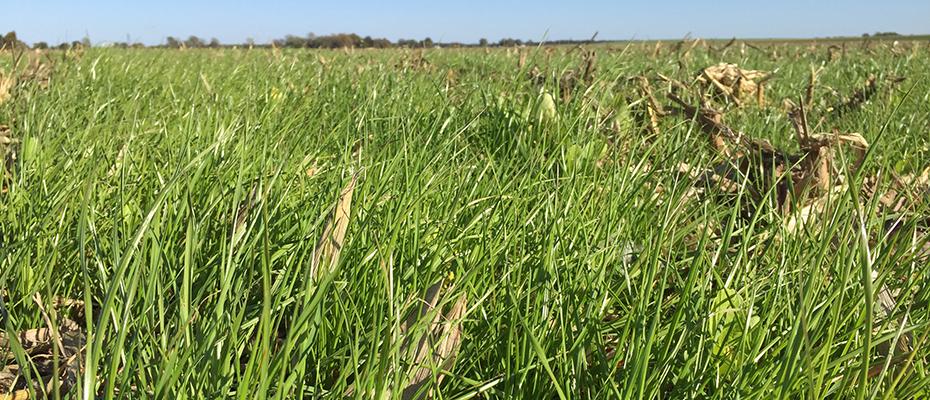Solving the Soil Health Puzzle? We Have you Covered. Cover crops are an important piece to soil health and future profit. We know it takes work and is puzzling at times. Soil First® provides quality products plus tips, tools and solutions to help cover crops work for you. As challenges arise, we are ready with the pieces you need to succeed.

Guardian Winter Rye cover crop seed is an upright, cool season annual grain that germinates in cool conditions. Very few species offer the many benefits that Guardian does while allowing extended planting flexibility long into the fall.
Guardian Winter Rye cover crop seed was carefully screened to provide dependable results in cover cropping situations. Excellent germination and early vigor in cooler temperatures, combined with solid winter-hardiness and quick, spring green-up make Guardian Winter Rye an excellent choice for a low-risk entry into cover cropping.
CHARACTERISTICS:
Non-Forage Benefits:
1 = Poor; 5 = Excellent
Compaction Alleviation: 4
Weed Suppression: 5
Biomass Production: 4
Erosion Control: 5
Disease/Pest Control: 3
Pollinator/Beneficials: 1
P & K Cycling: 4
Ease of Establishment: 4
Nitrogen Fixer/Scavenger: Scavenger
Nutritional Value:
Values Vary Greatly Depending on Maturity
Crude Protein: 10 (Hay); 14 (Silage)
NEL¹ Mcal/lb.: .58 (Hay); .59 (Silage)
ADF%²: 38 (Hay); 37 (Silage)
NDF%³: 65 (Hay); 59 (Silage)
TDN: 58 (Hay); 59 (Silage)
DM Tons/Acre: 3-5 (Hay); 2.5-4 (Silage)
Days to First Harvest: Spring
Days to Next Harvest: –
¹- Net Energy for Lactation = Energy available after subtracting digestive and metabolic losses
²- Acid Detergent Fiber = Low values mean more digestible
³- Neutral Detergent Fiber = Low values mean cows can eat more
Ranking (Good, Better, Best):
Graze: Good (Hay); NA (Silage)
Baleage: Better (Hay); Good (Silage)
Chop: Best (Hay); Best (Silage)
SEEDING:
Planting Time:
Aug.-Oct.
Seeding Rate:
Mono (lbs./acre): 30-50
Mix (lbs./acre): 20-40
Forage (lbs./acre): 80-120
Aerial (lbs./acre): 20-60
Seeding Info:
Carbon/Nitrogen Ratio (C:N): Vegetative- 20:1 (Hay); Straw- 80:1 (Silage)
Seeding Depth (in./with drill): 3/4-1
Seeds/lb.: 16-18,000
Bulk Density (lbs./ft.): 50 (Hay); – (Silage)
Aerial Application Rate: 20-60
Germination Soil Temp.: 34 F
USDA Hardiness Zone: 3
Days to Emergence: 5-8
MANAGEMENT:
Considerations
- Ideal pH = 5.0-7.0
- Quick spring growth can easily get away from many producers- have a plan to manage effectively
- Rye offers the advantage of being the easiest cereal grain to establish in poor soils and having the greatest cold tolerance. Rye offers the greatest production for hay or pasture ground because of its quick growth both in the fall and spring.
Removal Rates
-
- Equivalent 60 bushel yield crop, 80-100# N, 40# P, 60-70# K
Fertility
Fertilizer removal rates need to be considered as well. When utilizing cover crops as forage, it’s critical to consider the nutrients being removed along with the biomass. These fertilizer levels will need to be added to ensure maximum nutrient availability for the following cash crop.
Hay Production
Hay yields often average between 2-4 tons/acre. Moisture content should be between 15-20% moisture. Hay quality is more maturity-dependent at harvest than is silage.
The most efficient time to harvest small grain cereals for hay is at early-milk stage. This allows for the greatest compromise between forage yield and
quality (quality would be greatest at the late-boot stage). To help speed up drying, a crimper is recommended when harvesting in the late-boot stage
Silage Production
Wheat, barley, oat and triticale silage yields are similar, 4-7 tons/acre of 35% dry matter forage in the boot stage and closer to 6-10 tons/acre when harvested in the late-boot stage. Small grains should be ensiled at between 62–68% moisture. Chop length should be set finer than when harvesting corn or forage sorghum. (Kansas State University)

Ratings
Scale 1-9, where 9 = best or most pronounced
Compaction Alleviation
Weed Suppression
Biomass Production
Erosion Control
Disease/Pest Control
Pollinator/Beneficials
P & K Cycling
Ease of Establishment
- Created from strong demand for reliable seed from a trusted, weed-free source
- Screened for purity & cleanliness
- Excellent germination & early vigor (allows for later fall seedings)
- Strong winter hardiness
- More management considerations in Soil First® Management Guide
- > 90% Germ, > 98% Purity
- Best use: fall, winter & spring pasture












